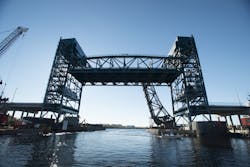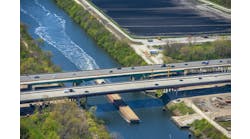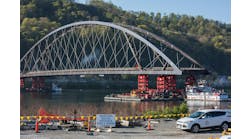When it came time to replace the Henry G. Gilmerton Bridge in the Hampton Roads region of Virginia in 2009, the project team had very strict parameters to work within. The span is one of five critical crossing points for the Elizabeth River in the region, resulting in major vehicle and boat traffic for the port area. Consequently, Virginia DOT required the bridge to stay open throughout construction. Modjeski & Masters examined several alternatives, including moving the bridge north or south, but the Coast Guard was adamant the new bridge had to be on the same alignment as the original structure. Added to which, a 100-year-old railroad bridge owned by Norfolk Southern sat just 25 ft to the south of the Gilmerton Bridge.
All of these constraints led to one reasonable conclusion: building a vertical lift bridge directly on top of the old span. “The tight site conditions drove everything else on this project, forcing some decisions that wouldn’t have been made on other projects,” Kevin Johns, deputy project manager for Modjeski & Masters, told Roads & Bridges.
To minimize disturbance to all of the surrounding structures, the project team installed eight 12-ft-diam. drilled shafts with steel casings to support the new span. Finding bedrock in which to plant the shafts was difficult due to the bridge’s location in the Great Dismal Swamp. Extensive geotechnical studies determined each shaft had to penetrate 120 ft below sea level, twice as deep as the old bridge’s foundations. This required a special oscillating crane attachment from German manufacturer Leffer.
“Cases of this size had never been oscillated before,” said Johns. Keeping vibrations to a minimum so as not to disturb the railroad bridge was paramount, so crews kept a close eye on seismic indicators and achieved their goal.
The new main spans were a towering 207 ft tall, every inch of which was required to achieve the needed 135 ft of vertical clearance.Once the new span was complete, the project team did a “float-in, float-out,” putting the old bridge on temporary supports while cutting it free and floating it out. At that point, the new bridge was floated in on barges and settled onto its supports.
Norfolk Southern allowed VDOT to use some of its right-of-way for the railroad bridge to expand the Gilmerton Bridge from four lanes to six. R&B



